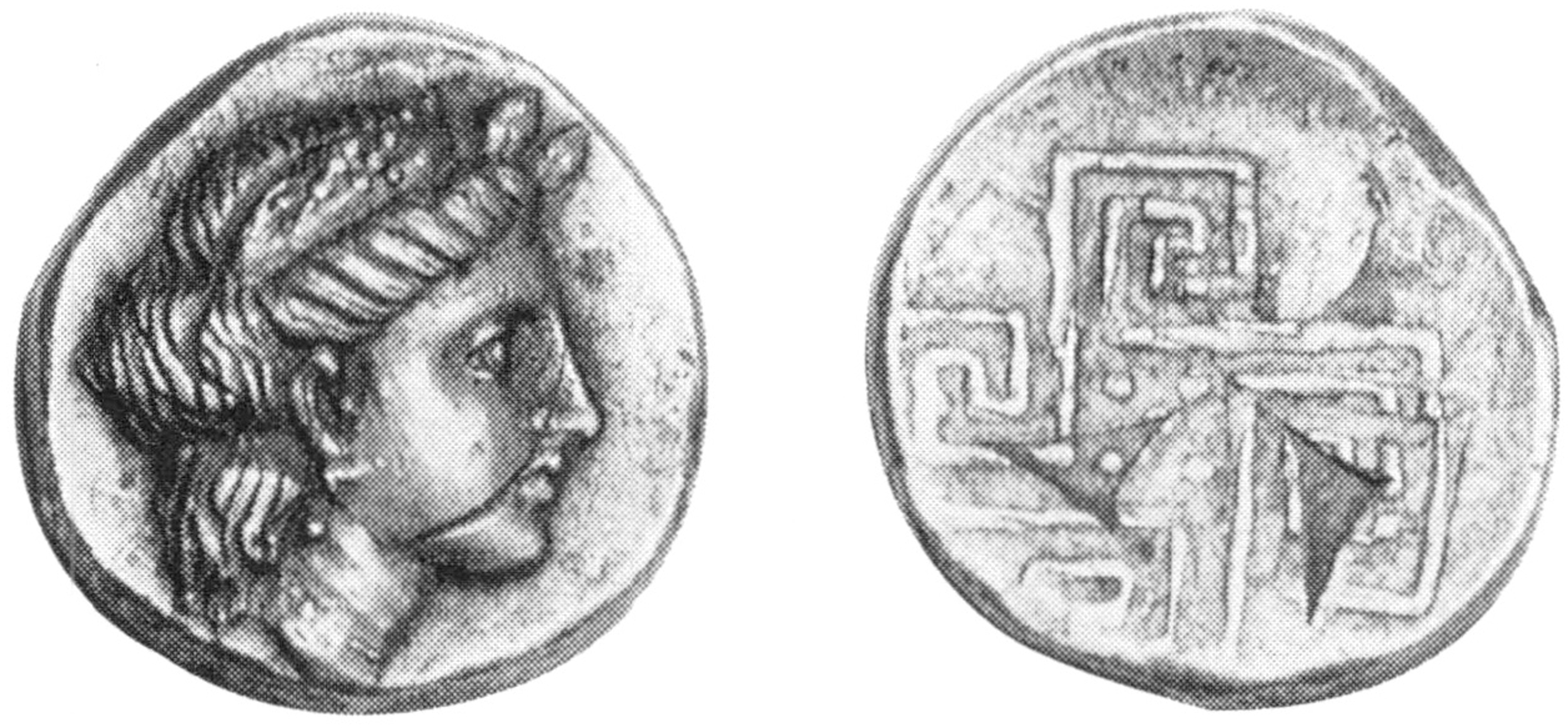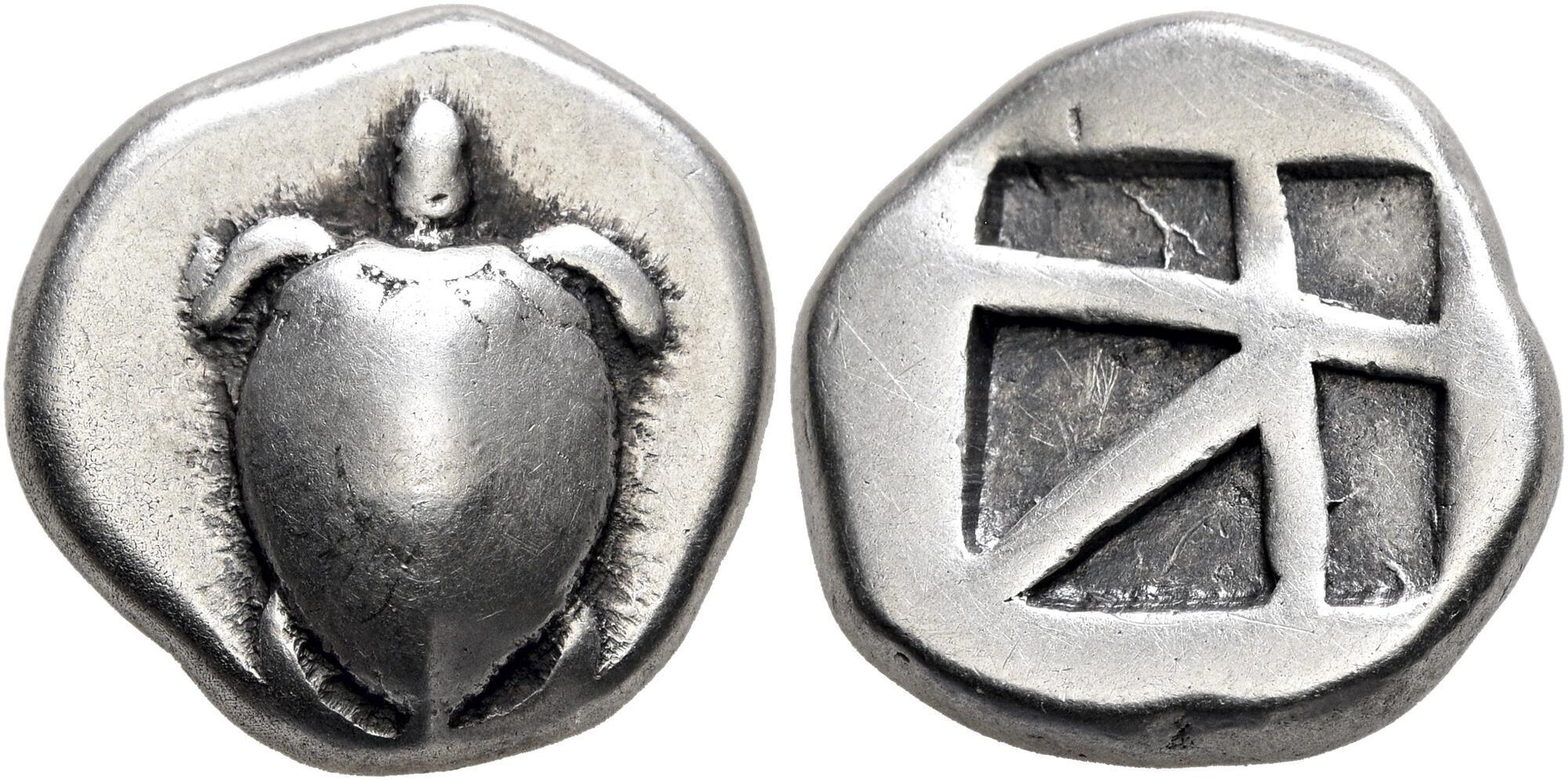21964 - Cnossus (stater Demeter/labyrinth) over Aegina (turtle/incuse square) (CNG, 49, March 1999, 537)
From SILVER
330 BCE - 300 BCE
Images
Overstriking coin

Cnossus_Classical_Numismatic_Group,_49,_17_March_1999,_537.jpg [1]
Location/history
| Sale(s)Sale(s) ᵖ: | Classical Numismatic Group, 49, 17 March 1999, 537 | |
Overstriking coin
Description
| ObverseInscription or printing placed on the obverse.: | Head of Demeter right | ReverseInscription or printing placed on the reverse.: | Labyrinth in the form of a swastika, five pellets in the center |
Mint and issuing power
| MintIdentifies the place of manufacture or issue of a numismatic object.: | Cnossus | Ancient regionAncient region. | Crete | Modern countryModern country: Crete | AuthorityIdentifies the issuing power. The authority can be "pretended" when the name or the portrait of X is on the coin but he/she was not the issuing power. It can also be "uncertain" when there is no mention of X on the coin but he/she was the issuing power according to the historical sources: |
Chronology
| FromIdentifies the initial date in a range assigned in a numismatic context. 330 BCE toIdentifies the final date in a range assigned in a numismatic context.. 300 BCE | Hellenistic 323-30 BC |
Physical description
| MetalThe physical material (usually metal) from which an object is made.: Silver |
WeightWeight of the numismatic object (in grams). in grams: 12.0212.02 g <br />12,020 mg <br /> | DenominationTerm indicating the value of a numismatic object. Examples: tetradrachm, chalkous, denarius.: stater |
|
| StandardStandard.: Aeginetic | |||
References
| Coin referenceReference of the Coin: | Coin series referenceReference to coin series study: | Svoronos 18901Svoronos 1890, n° 44, Le Rider 19662Le Rider 1966, pl. VII, 6, Carrier 20173Carrier 2017, n° 81-322 | |
| Coin series web referenceCoin series web references: | |||
Overstruck type
Description
| ObverseInscription or printing placed on the obverse.: | Turtle | ReverseInscription or printing placed on the reverse.: | Invuse square |
Mint and issuing power
| MintIdentifies the place of manufacture or issue of a numismatic object. ᵖ: | Aegina | Ancient regionAncient region. ᵖ | Attica | Modern countryModern country: Greece | AuthorityIdentifies the authority in whose name (explicitly or implicitly) a numismatic object was issued. ᵖ: |
Chronology
| FromIdentifies the initial date in a range assigned in a numismatic context. 450 BCE toIdentifies the final date in a range assigned in a numismatic context.. 350 BCE | Classical 480-323 BC |
Physical description
| DenominationTerm indicating the value of a numismatic object. Examples: tetradrachm, chalkous, denarius. ᵖ: | stater |
References
| Coin type referenceReference to coin series study ᵖ: |
Additional data
| Frequency of overstrikesFrequency of overstrikes: | rare and concentrated | Level of confidenceLevel of confidence of the identification: | strong |
| RemarksRemarks: | "Overstruck on an Aegina stater, with the outline of the turtle's shell and incuse visible" | ||
References
- ^ Svoronos, Ioannes N. (1890), Numismatique de Crète ancienne, accompagnée de l'histoire, la géographie et la mythologie de l'île. Première partie, description des monnaies, 2 vol., Macon, Impr. Protat frères.
- ^ Le Rider, Georges (1966), Monnaies crétoises du Ve au Ier siècle av. J.-C., Paris, Geuthner, 345 p. and 42 pl.
- ^ Carrier, Caroline (2017), Cnossos de l'époque classique à l'époque impériale (Ve s. avant J.-C.-Ier s. après J.-C.). Etude de numismatique et d'histoire, Unpublished doctoral dissertation, Paris-Sorbonne University.
